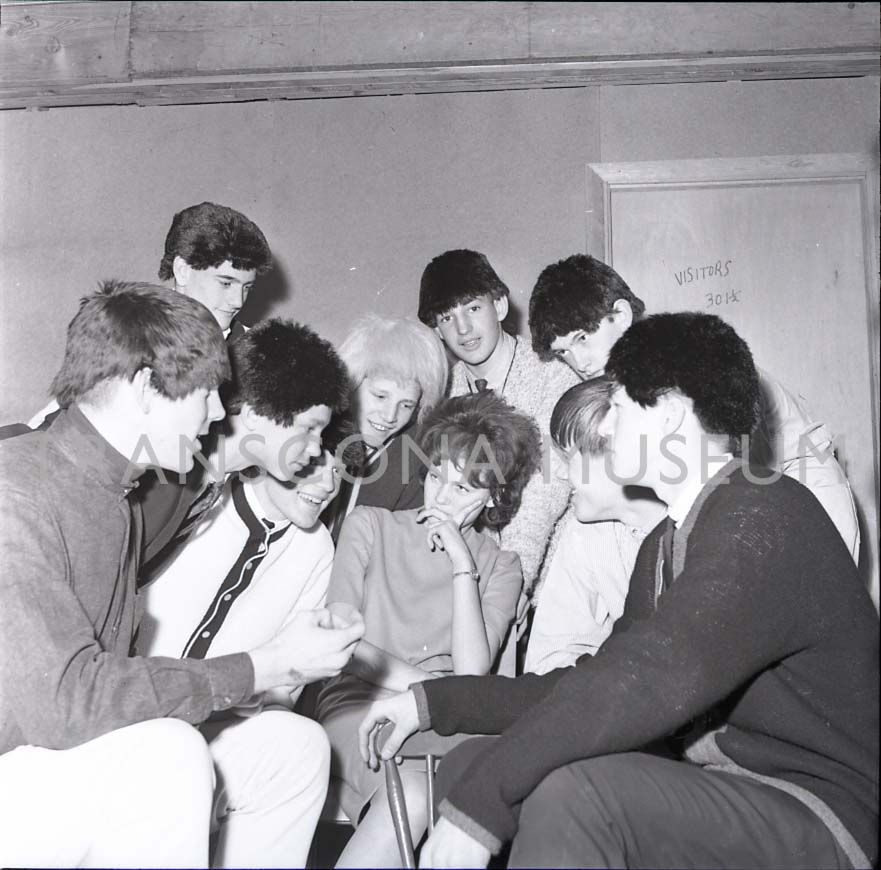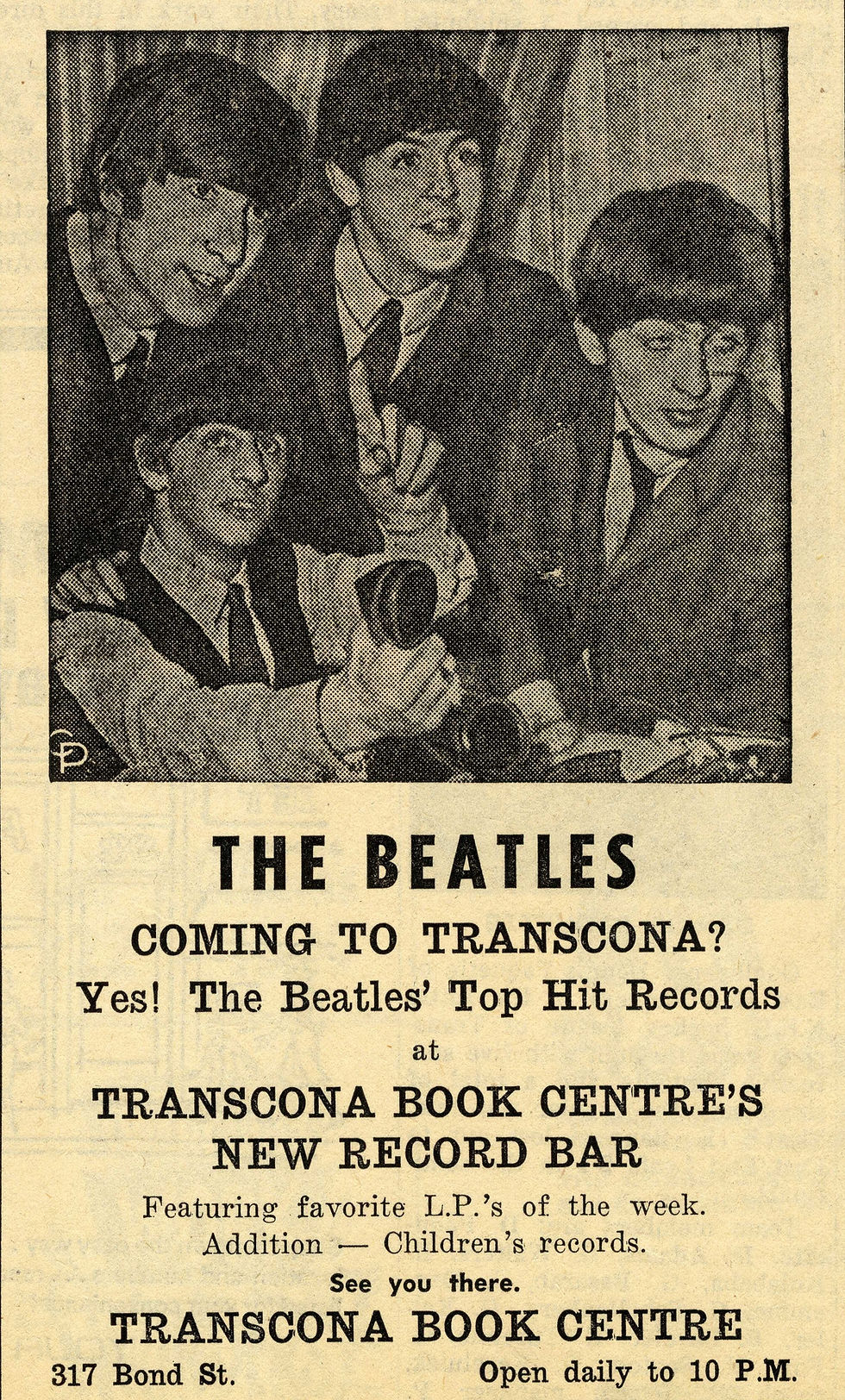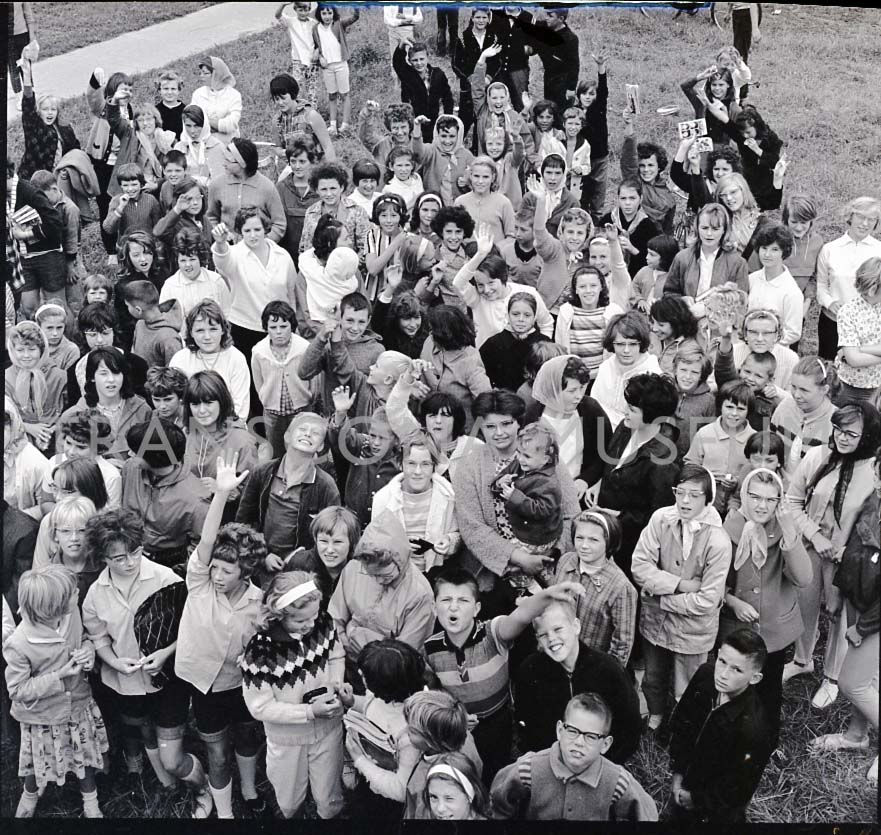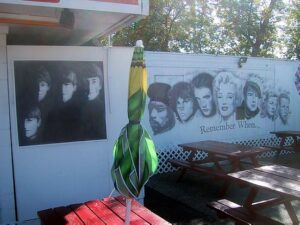There is no doubt that Transcona has a vibrant history ever since its establishment in 1912; its existence began in the most turbulent century in the history of the world. When the First World War began in 1914, the men and women of Transcona responded heroically. In 1921, Transcona filed for bankruptcy and staggered into the 1930s with the added struggle of the Depression. By 1939, the Second World War began, and the men and women of Transcona again responded heroically. After 1945, Canada began to boom into post-war glory from years of social and financial hardship. Transcona started to see the benefits of a growing post-war economy and saw the town's expansion into a city in 1961. Transcona has seen its fair share of change, but one particular change was difficult to reconcile: the fever of Beatlemania.
Beatlemania began in the United Kingdom and Europe in 1963, but their breakthrough to North American audiences still needed to be achieved. On February 9th, 1964, the Beatles had their first major worldwide debut on the Ed Sullivan Show to millions of viewers. With their Ed Sullivan Show debut came their first major rise in popularity and reach to the far corners of the world; Transcona would not be left out of the equation.
The first mention of the Beatles in the Transcona News occurred in the February 20th, 1964 edition, only 11 days after their Ed Sullivan Show debut. On page eight, an excerpt of the page reads “HERE THEY ARE GIRLS” with a picture of the four Beatles. The article read, “In the United States for a 10-day tour, England’s gyrating song stylists, The Beatles, gather around a telephone in their New York City Hotel.” This article's particular wording would be the precursor to how Transconian adults and elders would handle Beatlemania in the coming months.
The first page of the February 27th, 1964 edition of the Transcona News brings an interesting reaction to the introduction of the Beatles' hairstyle from the Transcona youth. The headline at the bottom of the page reads, “‘Beatle’ Hair Styles Not for Div. Schools.” The Transcona News surveyed the principals of three Division collegiates, who showed that they were all opposed to the "'down-on-all-sides-bowl-type’” haircut. At the time, the Principal of Murdoch McKay Collegiate, George Derenchuk, had this to say of the haircuts and wigs: "'The school is a place to study and not to attract attention which this hairdo does….If the student wants attention, let him score good marks and we’ll announce it every day!'” Principal Mel Belluk of Springfield Collegiate was recorded as saying that if the hairstyles arose in his school, “'I would be inclined to discourage it.'” Perhaps one of the most striking quotes from the school faculty was that of Steve Quelch, a much-respected community member, a large contributor to education and to the Transcona Museum with his vast butterfly and moth collection. Mr. Quelch responded to the haircuts, stating, “'One of the most important factors in the success of a school as a whole or as an individual student is a proper attitude to the job to be done…Anything that detracts from this attitude is out of place…I feel that any extremes of fashion, dress or conduct designed to attract undue attention are detrimental to the studious attitudes required in the school. I would not tolerate a ‘Beatle’ hairdo in the Transcona Collegiate.'" These reactions eventually led to the banning of the Beatles hairstyle in Transcona schools.
The response of school faculty to the excitement was not entirely unjustified. Beginning in February 1964 with The Beatles' Ed Sullivan Show appearance, Beatlemania was at its full peak and created a mass hysteria never seen in the history of the world. The Beatles challenged the social conformities of the 1940s and 1950s with their carefree attitude, humour, and longer hairstyles, which contended with traditional masculinity at the time. The Beatles' popularity had spread so much worldwide that even a smaller city like Transcona could not escape their massive wave. The Beatles' change to youth culture was drastic and quick, so much so that it was intimidating for the older generation as this type of change was never seen before. The greatest generation became paranoid and anxious about the baby boomers' behaviour, seeing hysterical, screaming girls and boys becoming obsessed with the Beatles' fashion, music, and personalities. The Beatles, even in their early years, had come off as very anti-establishment, especially from the conduct of John Lennon in interviews, often giving a humorous, sarcastic tone. The Beatles were seen as the degeneration of youth culture from the traditional/conservative, military, nuclear-style family of decades previous. This generational divide and skepticism pattern has existed throughout history but was most extreme in the 1960s with the Beatles' influence.
However, banning the Beatles' haircut did not stop the Transcona youth from partaking in the exciting music and youth culture. In the same February 27th, 1964 edition of the Transcona News, on page five, in the “Classified Ads” section, at the bottom of the page, we see an advertisement, “THE BEATLES - COMING TO TRANSOCNA? Yes! The Beatles’ Top Hit Records at TRANSCONA BOOK CENTRE’S NEW RECORD BAR... See you there.” It seems that the Beatles could not be stopped in all aspects as their music was still promoted by a local business and the Transcona News.
During their first North American tour, the Beatles would briefly stop in Winnipeg on August 18th, 1964, for a plane refuelling (for 35 minutes). Winnipeg would become the first Canadian city where the Beatles ever stepped foot. The plane would land to a jubilant crowd of screaming and hysterical fans waiting at Winnipeg International Airport (the airport's name at the time). In the August 27th, 1964 edition of the Transcona News, pictures of the four Beatles appear on page 11, taken from their brief stopover.
One of the most notable parts of their Winnipeg visit was the infamous “Decker Dash,” where Winnipeg resident Bruce Decker attempted to rush the Beatles plane to meet them but was ultimately stopped by the RCMP. This type of reaction from the youth at the time further prompted the greatest generation to be on guard of what they saw as the threat Beatlemania posed to their understanding of youth order and discipline.
In the September 3rd, 1964 edition of the Transcona News, we see some minor coverage of a Beatles’ day hosted by the news office in August.
On page twelve of the same edition, we get a true glimpse of the effect of the Beatles on Transconian youth. “There were 200 members of the younger generation congregating at the News office last Friday afternoon where 20 pictures of the Beatles were handed out free to lucky ticket winners. The winners were speechless with joy while some losers shed tears.”
From then on, the Transcona News would cease to cover The Beatles aside from the initial Beatlemania craze of 1964. However, something significant comes from its shockwave. A little over a year and a half after the initial Beatlemania phase, opening advertisements for two of Transcona's most well-known music clubs in the Winnipeg/Transcona music scene, the Pink Panther and The Den, appeared in the December 9th, 1965 edition of the Transcona News. Undoubtedly, Beatlemania did not just help with the popularity of the Beatles but also initiated the popularity of all rock and roll in Transcona.
John Einarson, acclaimed Winnipeg music historian, wrote about the Pink Panther and The Den in an article for Winnipeg Boomer Magazine in December of 2011 entitled, "When Winnipeg hopped: Recalling the teen nightclubs of the mid-1960s." Einarson writes, “Transcona was not immune to the rock ‘n’ roll fever gripping teens in the 60s. Two teen clubs opened in the mid-60s, the first being The Den at 201 Bond Street across from Dominion Lumber. More akin to a coffeehouse than a nightclub, The Den was tiny…The small stage was barely able to accommodate a drum kit. The Pink Panther was located in a vacant bowling alley in the Regent Park Shopping Centre.…It featured a giant portrait of a pink panther on the back wall. It was a larger club and because of its former use, the ceiling sloped downward toward the bandstand, where the pins used to stand at the end of the alley, necessitating some crouching from drummers. The Orfans’ Dutch Schultz would thrust his drumsticks into the ceiling tiles right above his head at the start of a break, retrieving them once the next set got underway. Sunday evening shows were popular, drawing kids from across the city. ‘We referred to The Pink Panther as our second home,’ states Terry Stiles, whose band Satan & the D-Men appeared frequently at the club, ‘and the food was great, especially the hamburgers.’ Nyckles & Dymes guitarist Ralph Gammelseter recalls, ‘Our manager brought a skinny kid to audition for lead singer at the Pink Panther. The kid was George Belanger [later of Harlequin fame]. We hired him after the first song.’”
First hand accounts of both clubs are scarce so if anybody reading this would like to share their experiences, please contact the Transcona Museum to share your stories.
In the January 11th, 1967 edition of the Transcona News, a compelling photograph appears on page seven. Students Ray Carney, Pat Ireland, Larry Martineau and Roger Colpittson are shown playing together in a band. The accompanying article states that when they first started, they practiced every free hour possible, including after school and on Saturdays and Sundays. They also had no professional training and played by ear. They came out on top at the Battle of the Bands at the Transcona Collegiate Institute. The article also reports that they played the Pink Panther for no compensation to get their stage chops and experience reception from a crowd. The article's headline says they were "the sound we've been missing." A video https://www.youtube.com/watch?v=qaNUIb6FLv0 on the history of music in Transcona features the photo on the Transcona Museum’s YouTube channel.
The bass guitar in that photo held by Roger Colpittson is the same model Paul McCartney used throughout his entire Beatles career, a Höfner 500/1 Violin Bass. The popularity of the bass was initiated by Paul McCartney’s use, especially when Höfner violin bass sales soared after the Beatles' Ed Sullivan Show appearance. The Gibson SG, held by Larry Martineau, was also used by George Harrison live and during recording sessions. However, the Gibson SG was a common and popular model among many musicians then, so it is more likely a coincidence that Martineau used it, while the Höfner violin bass is more of an obvious nod to the Beatles and McCartney.
The love for the Beatles among the 1960s Transcona youth came full circle in 1993 and 2013. In an article by Dan Falloon for the Winnipeg Free Press, entitled "Transcona connections to Macca abound," it is revealed that Transcona resident Barb Burkowski, a drummer with the Heather-Belle Ladies Pipe Band played with McCartney at his 1993 show in Winnipeg after cold-calling the promoters. After Burkowski’s cold-calling, she managed to maintain a good connection with the concert promoters for McCartney, so much so that when McCartney was set to perform at Investors Group Field on August 12th, 2013, Burkowski was ready to get her new band, the Winnipeg Police Pipe Band, onstage with him. Pipe major for the Winnipeg Police Pipe Band, Doug Roxburgh, who also grew up in Transcona, said the band had been in contact with Live Nation for months and had been given the green light a week before the 2013 show. "Roxburgh said being able to perform with a living legend was a heart-pumping experience, especially after receiving a raucous welcome from the crowd of 31,200. 'The best way to describe it is a complete ‘wow’ factor,' he said. 'We tuned more into it after the fact that we’d done our job because as much as it was overwhelming being on the stage, we really had to focus on being in sync with the McCartney band.' Roxburgh said the band certainly had some nerves going in, as they only got to rehearse with McCartney during sound check. They did get a vote of confidence right off the bat, though. 'Paul looked at his guitar player and gave a big smile of approval — that was a big confidence boost for us,' he said."
In a way maybe it was Paul McCartney giving a smile to all the people of Transcona.
Sources
Decker Dash. 2011. ReadReidRead. https://readreidread.wordpress.com/2011/04/16/the-beatles-in-winnipeg/.
Einarson, John. 2014. “The Run of His Life: John Einarson Remembers Decker’s Dash: Musician best known for sprinting towards Beatles during brief airport stop.” Winnipeg Free Press, August 17, 2014. https://www.winnipegfreepress.com/arts-and-life/entertainment/music/2014/08/17/the-run-of-his-life.
Einarson, John. 2011. “When Winnipeg hopped: Recalling the teen nightclubs of the mid-1960s.” Uberflip, December 2011. Accessed July 17, 2024. https://read.uberflip.com/i/49206-december-2011/27?
Einarson. 2018. Satan & the D-Men at the Pink Panther. Facebook. https://www.facebook.com/groups/177889445583606/posts/1783729958332872/?_rdr.
Einarson. 2018. The Quid Playing the Den. Facebook. https://www.facebook.com/groups/177889445583606/posts/1783729958332872/?_rdr.
Falloon, Dan. 2013. “Transcona Connections to Macca Abound.” Winnipeg Free Press: Our Communities, August 21, 2013. https://www.winnipegfreepress.com/our-communities/herald/2013/08/21/transcona-connections-to-macca-abound.
Hochberg, Jeff. 1966. The Beatles’ Final UK Concert. Getty Images. https://gettyimagesgallery.com/images/the-beatles-final-uk-concert/.
Transcona Biz. n.d. Remember When Mural. Transcona Biz. https://transconabiz.ca/community-programs/murals-public-art/maggis/.
Transcona News. 1965. “Advertisements for The Den and the Pink Panther.” Transcona News, December 9, 1965.
Transcona News. 1964. “‘Beatle’ Hair Styles Not For Div. Schools.” Transcona News, February 27, 1964.
Transcona News. 1964. “HERE THEY ARE GIRLS.” Transcona News, February 20, 1964.
Transcona News. 1964. “News Office Beatles’ Day.” Transcona News, September 3, 1964.
Transcona News. 1967. “That’s the sound we’ve been missing.” Transcona News, January 11, 1967.
Transcona News. 1964. “The Beatles’.” Transcona News, August 27, 1964.
Transcona News. 1964. “THE BEATLES - COMING TO TRANSOCNA? Yes! The Beatles’ Top Hit Records at TRANSCONA BOOK CENTRE’S NEW RECORD BAR.” Transcona News, February 27, 1964, sec. Classified Ads.
















Comments